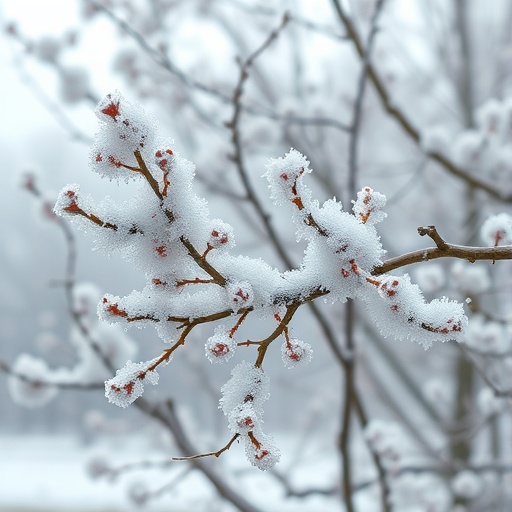Hopes high as hundreds of critically endangered frogs survive release into wild in Victoria – The Guardian

Conservation Initiative for Spotted Tree Frog Aligns with Sustainable Development Goals
Introduction: Addressing SDG 15 (Life on Land)
A conservation breeding program in Victoria, Australia, is undertaking significant action to halt biodiversity loss and prevent the extinction of a threatened species, directly contributing to the objectives of Sustainable Development Goal 15 (Life on Land). The initiative focuses on the critically endangered spotted tree frog, whose habitat was severely impacted by climate-related disasters.
- Species: Spotted Tree Frog (Critically Endangered)
- Location: Kiewa River, near Mount Beauty, Victoria
- Primary Objective: To boost dwindling wild populations and restore genetic diversity, in line with SDG Target 15.5, which calls for urgent action to protect threatened species and halt biodiversity loss.
Program Implementation and Multi-Stakeholder Collaboration (SDG 17)
The success of the reintroduction program is underpinned by effective multi-stakeholder partnerships, a core principle of SDG 17 (Partnerships for the Goals). The project demonstrates a collaborative effort between scientific bodies, government agencies, and the local community.
Key Partners:
- Zoos Victoria
- Wild Research
- University of Melbourne ecologists
- Traditional Owners
- Recreational fishers and community members
Release Cohorts:
Over 600 captive-bred frogs have been released to augment the wild population. The releases were staged to maximize survival rates:
- A 2024 cohort of 300 tadpoles and 70 juvenile frogs.
- A subsequent release of 265 one-year-old frogs.
Ecological Challenges and Climate Resilience (SDG 13 & SDG 14)
The program directly responds to threats exacerbated by climate change, a key focus of SDG 13 (Climate Action). The 2019-20 Black Summer bushfires, a climate-related natural disaster, destroyed 50% of the frog’s Victorian habitat, making this intervention critical for species survival and ecosystem resilience.
Primary Threats to the Species:
- Habitat Degradation: Severe habitat loss from bushfires.
- Disease: The pathogenic chytrid fungus.
- Invasive Species: Predation by introduced fish, such as trout, which impacts the health of freshwater ecosystems, a concern related to SDG 14 (Life Below Water).
- Extreme Weather: Increased risk of flash flooding.
Monitoring, Results, and Future Outlook
Initial monitoring indicates promising results for the long-term recovery of the species. The findings highlight the viability of captive-breeding and release programs as a tool for achieving conservation targets.
Key Findings:
- High Survival Rate: Post-release tracking has successfully located more than half of the released frogs, indicating a high rate of survival.
- Successful Adaptation: The frogs are integrating into the landscape, with some individuals moving a considerable distance of up to one kilometre from the original release point.
- Strategic Site Selection: The Kiewa River site was chosen for its lower abundance of predatory trout and a limited canopy. The increased sunlight allows frogs to warm themselves, an activity believed to help them combat the chytrid fungus, reinforcing the link between habitat quality and species health.
Continued monitoring by the collaborative team will track the long-term health and survival of the population. The initial success provides significant hope for the recovery of the spotted tree frog, demonstrating a tangible outcome for actions aligned with the UN Sustainable Development Goals.
Analysis of SDGs, Targets, and Indicators
-
Which SDGs are addressed or connected to the issues highlighted in the article?
-
SDG 15: Life on Land
This goal is central to the article, which focuses on protecting, restoring, and promoting the sustainable use of terrestrial and freshwater ecosystems. The entire initiative described—the captive breeding and release of the critically endangered spotted tree frog—is a direct action to halt biodiversity loss and protect a threatened species and its habitat.
-
SDG 13: Climate Action
This goal is relevant because the article explicitly links the decline of the frog’s habitat to a climate-related disaster. It states that “50% of the frog’s Victorian habitat was severely burnt in the 2019-20 black summer bushfires.” The conservation program is, in part, a response to the impacts of climate change on the species’ survival, aiming to build resilience in the population.
-
-
What specific targets under those SDGs can be identified based on the article’s content?
-
Target 15.5: Take urgent and significant action to reduce the degradation of natural habitats, halt the loss of biodiversity and, by 2020, protect and prevent the extinction of threatened species.
The article is a case study of this target in action. The spotted tree frog is described as “critically endangered,” and the Zoos Victoria conservation program is an urgent measure designed to “prevent the extinction” of this species by boosting its numbers and genetic diversity in the wild.
-
Target 15.8: By 2020, introduce measures to prevent the introduction and significantly reduce the impact of invasive alien species on land and water ecosystems and control or eradicate the priority species.
The article identifies “predation by introduced fish species such as trout” as a major threat to the frogs. The selection of the reintroduction site was based on its “lower trout abundance, meaning fewer predators,” which demonstrates a measure to reduce the impact of an invasive alien species on the local ecosystem.
-
Target 15.1: By 2020, ensure the conservation, restoration and sustainable use of terrestrial and inland freshwater ecosystems and their services…
The conservation efforts are focused on the “fast-flowing mountain stream near Mount Beauty” and the “Kiewa River,” which are inland freshwater ecosystems. The program aims to restore a key component of this ecosystem’s biodiversity (the frog population), contributing to its overall health and conservation.
-
Target 13.1: Strengthen resilience and adaptive capacity to climate-related hazards and natural disasters in all countries.
The black summer bushfires are cited as a major climate-related disaster that destroyed half of the frog’s habitat. The reintroduction program is an effort to strengthen the resilience of the species by repopulating areas and increasing genetic diversity, helping it adapt and recover from such events.
-
-
Are there any indicators mentioned or implied in the article that can be used to measure progress towards the identified targets?
-
Number of captive-bred animals released
The article provides specific numbers to quantify the conservation effort: “More than 600 spotted tree frogs have joined dwindling wild populations,” including “265 one-year-old frogs” and a previous cohort of “300 tadpoles and 70 juvenile frogs.” This is a direct measure of the scale of the intervention.
-
Survival rate of released animals
Progress is measured by tracking the survival of the released frogs. The article states, “So far more than half of the animals released have been found again,” and “Quite a large proportion of those animals are actually surviving.” This serves as a key performance indicator for the success of the reintroduction program.
-
Abundance of invasive species
The article implies that the density of the invasive trout population is a monitored variable. The reintroduction site was chosen for its “lower trout abundance,” indicating that the level of this threat is a measurable factor in conservation planning.
-
Proportion of habitat affected by natural disasters
The article provides a clear metric for the impact of the bushfires: “50% of the frog’s Victorian habitat was severely burnt.” This figure serves as a baseline indicator of the damage that conservation efforts are working to overcome.
-
-
SDGs, Targets, and Indicators Table
SDGs Targets Indicators SDG 15: Life on Land 15.5: Protect and prevent the extinction of threatened species. - Number of captive-bred animals released (over 600).
- Survival rate of released frogs (“more than half”).
15.8: Reduce the impact of invasive alien species. - Abundance of invasive species (selection of site with “lower trout abundance”).
15.1: Ensure the conservation and restoration of inland freshwater ecosystems. - Implementation of a species reintroduction program in a mountain stream ecosystem.
SDG 13: Climate Action 13.1: Strengthen resilience to climate-related hazards and natural disasters. - Proportion of habitat affected by natural disasters (“50%… severely burnt in the 2019-20 black summer bushfires”).
Source: theguardian.com

What is Your Reaction?
 Like
0
Like
0
 Dislike
0
Dislike
0
 Love
0
Love
0
 Funny
0
Funny
0
 Angry
0
Angry
0
 Sad
0
Sad
0
 Wow
0
Wow
0









































































